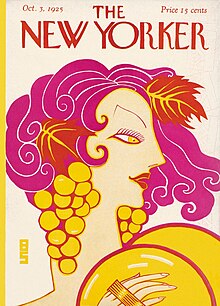| Barbara Shermund | |
|---|---|
 Self portrait of Shermund Self portrait of Shermund | |
| Born | (1899-06-26)June 26, 1899 San Francisco, California, U.S. |
| Died | September 9, 1978(1978-09-09) (aged 79) Middletown Township, New Jersey, U.S. |
| Education | California School of Fine Arts |
| Occupation | Cartoonist |
| Employer | New Yorker |

Barbara Shermund (June 26, 1899 – September 9, 1978) was an American cartoonist whose work appeared in The New Yorker from its first year in 1925. She was one of the first three women cartoonists inducted into the National Cartoonists Society in 1950.
Early life and education
Barbara Shermund was born in San Francisco on June 26, 1899. Her father, Henry Shermund, was an architect and her mother, Fredda Cool, was a sculptor. Shermund's talent emerged very early in her life and her parents encouraged her to follow her passion. She attended the California School of Fine Arts and studied painting and printmaking. Her first artwork was published when she was nine years old on the San Francisco Chronicle's children's page under the title 'On the farm'. In 1911, she published a short story for a writing contest in The San Francisco Call. She moved to New York in 1925 after her mother's death from Spanish flu. Initially she stayed with friends, either in New York City or in Woodstock. When her father remarried, it was to a woman who was eight years younger than she.
Cartoon career
Shermund began her career in New York by creating spot illustrations. Her first cartoon appeared in January 1926. She created covers, illustration and cartoons for Esquire, Life and Collier's.
In February 1925, Harold Ross launched The New Yorker as a humorous Manhattan-centric magazine. Shermund was one of the first women cartoonist to work for The New Yorker after its launch. Shermund supplied a cover in June and in October and she became a frequent contributor. Over 600 of her cartoons were published in The New Yorker and also contributed nine cover illustrations for the magazine. Shermund wrote her own captions under her cartoons. Her creations were satirical and often had a feminist and poignant tone reflecting the early 20th century view of the New Woman. One cartoon showed two men seated by a fire with the caption, "Well, I guess women are just human beings after all." Shermund also contributed to magazines like Life, Colliers, Judge, and many others.
Shermund's classical training characterised her style. Her cartoons can be identified by their bold, loose lines. She used pencil and brush and she sketched a first draft on heavy 24 x 36 inch watercolour paper. Unlike other artists, She did not have a studio and she used to draw at her kitchen table. Her work evolved along with the magazine. In the 1930s, her style started to change. Her strong female voice altered as the magazine evolved. By the 1940s, her cartoons were stylised and less realistic with less poignant captions. From 1944 to 1957, she produced "Shermund's Sallies", a syndicated cartoon panel for Pictorial Review, the arts and entertainment section of Hearst's many Sunday newspapers. Shermund, Hilda Terry and Edwina Dumm were the first three women cartoonists inducted into the National Cartoonists Society in 1950. Shermund continued to draw at her home in Sea Bright, New Jersey, until shortly before her death.
Death and legacy
Shermund died in a nursing home in Middletown Township, New Jersey, in 1978 after losing contact with her family. 35 years later, when her niece searched for Shermund's burial site, she was surprised to find that her ashes remained in a nursing home. In 2018, her niece helped to crowdfund the burial of the ashes and the erection of a headstone. In 2022, the New York Times published a belated obituary for Shermund.
Shermund's life and work will be recounted in Tell Me a Story Where the Bad Girl Wins: The Life and Art of Barbara Shermund, an upcoming biography edited by Caitlin McGurk and to be published in November 2024 by Fantagraphics. The Brandywine Conservancy and Museum of Art, Chadds Ford, PA, will have a show of her works 15 Feb.-15 May 2025.
References
- ^ Challa, Janaki (March 4, 2022). "Overlooked No More: Barbara Shermund, Flapper-Era Cartoonist". The New York Times. ISSN 0362-4331. Archived from the original on March 21, 2022. Retrieved March 21, 2022.
- ^ Donnelly, Lisa (2021). Very Funny Ladies: The New Yorker's Woman Cartoonists. Promethus Books. pp. 61–72.
- ^ "Tell Me a Story Where the Bad Girl Wins: The Life and Art of Barbara Shermund". Billy Ireland Cartoon Library and Museum. October 10, 2018. Archived from the original on December 6, 2021. Retrieved March 21, 2022.
- "Shermund Art for Sale". Conde Nast. Archived from the original on March 23, 2022. Retrieved March 23, 2022.
- "New Yorker October 3rd, 1925 by Barbara Shermund". Conde Nast. Archived from the original on April 22, 2021. Retrieved March 23, 2022.
- "About Us". The New Yorker. June 10, 2017. Archived from the original on February 24, 2020. Retrieved March 21, 2022.
- ^ McGurk, Caitlin (November 19, 2024). "Tell Me a Story Where the Bad Girl Wins: The Life and Art of Barbara Shermund". Fantagraphics.
- "Barbara Shermund". Billy Ireland Cartoon Library & Museum Blog. Archived from the original on February 24, 2022. Retrieved March 23, 2022.
- MacDonald, Heidi (December 21, 2018). "Pioneering woman cartoonist Barbara Shermund's remains lay unclaimed for 35 years – but now you can help bury her at last". The Beat. Archived from the original on January 12, 2022. Retrieved March 25, 2022.